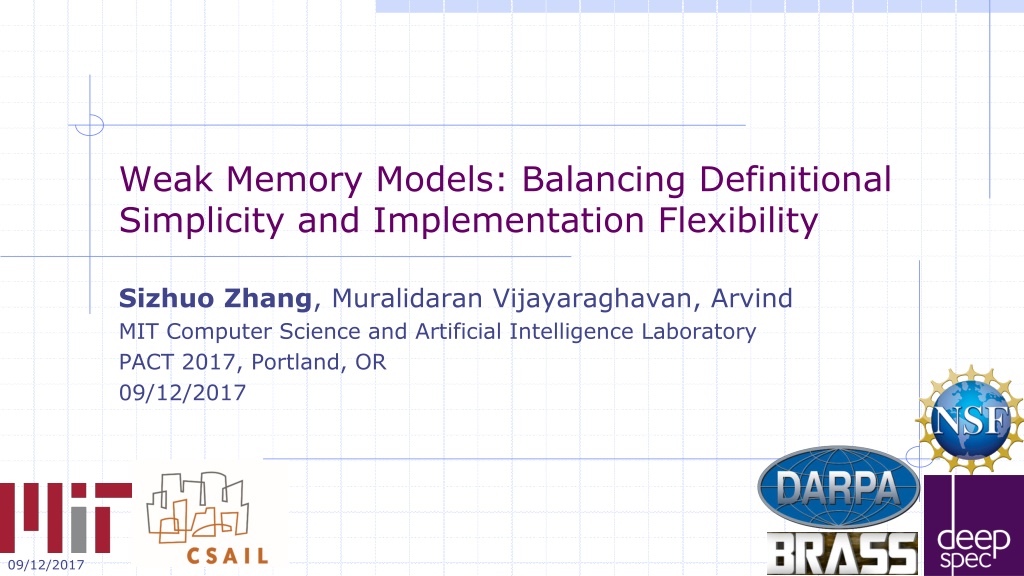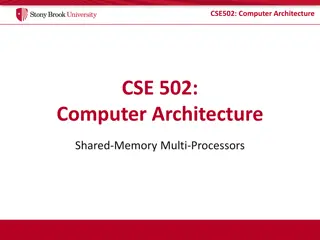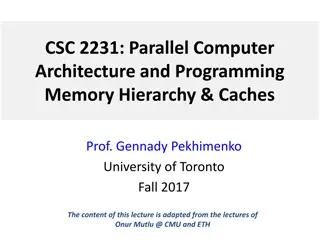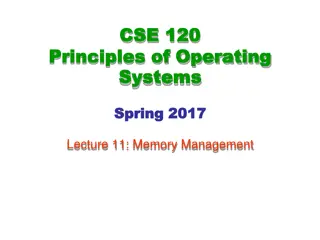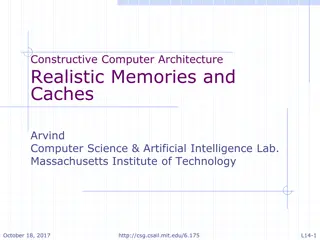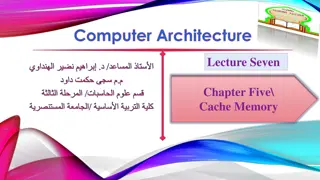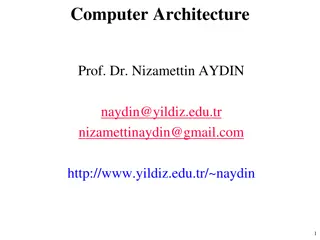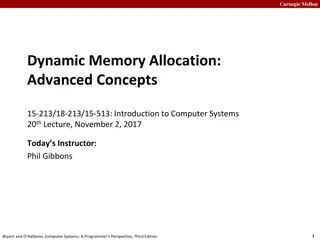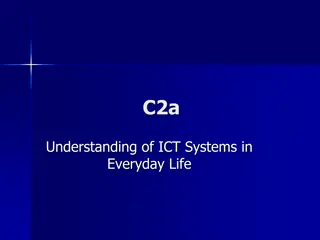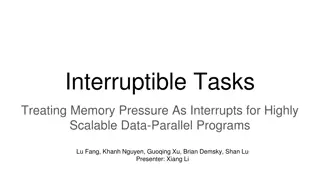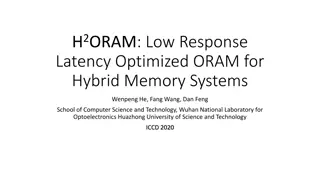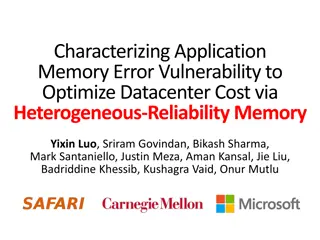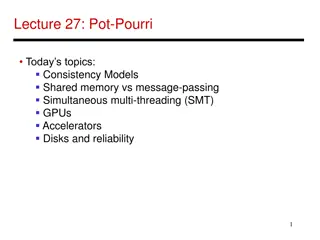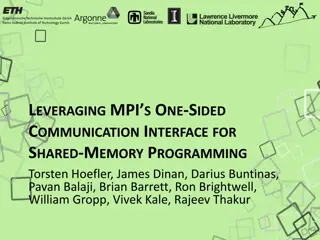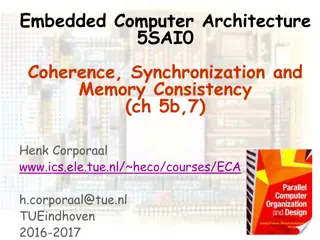Understanding Memory Models in Computer Architecture
Memory models in computer architecture dictate the legal behaviors of multiprocessors and play a critical role in ensuring system reliability and performance. They balance definitional simplicity with implementation flexibility, impacting optimizations and overall system design. This article explores the significance of memory models, the Ultimate Memory Model (UMM) for optimal performance, and operational and axiomatic definitions in the context of program behavior and memory systems.
Download Presentation

Please find below an Image/Link to download the presentation.
The content on the website is provided AS IS for your information and personal use only. It may not be sold, licensed, or shared on other websites without obtaining consent from the author. Download presentation by click this link. If you encounter any issues during the download, it is possible that the publisher has removed the file from their server.
E N D
Presentation Transcript
Weak Memory Models: Balancing Definitional Simplicity and Implementation Flexibility Sizhuo Zhang, Muralidaran Vijayaraghavan, Arvind MIT Computer Science and Artificial Intelligence Laboratory PACT 2017, Portland, OR 09/12/2017 09/12/2017 1
What is a memory model? Memory model defines the legal behaviors of multiprocessors for an ISA Challenge: Microarchitectural optimizations that are transparent in the uniprocessor setting induce behaviors that cannot be explained if instructions are executed one at a time in the multiprocessor setting If the memory model forbids a behavior caused by an optimization, then the implementer may either not use the optimization (e.g., prevent some instruction reordering) less performance, or perform the optimization speculatively and then squash the execution if it creates a forbidden behavior more area and power 09/12/2017 2
The Ultimate Memory Model (UMM) For the best PPA (performance, power, and area), the ultimate memory model (UMM) should allow exactly those behaviors that correspond to the most optimized uniprocessors connected to an atomic shared memory system* *An atomic memory system can be abstracted to monolithic memory which executes loads and stores instantaneously Implementations of atomic memory are well understood in terms of coherent cache hierarchies SC, TSO, PSO, RMO, Alpha, and ARMv8.2 use atomic memory while ARMv7 and POWER do not ARM has recently shifted to an atomic memory model in its version 8 We will sketch such a UMM to illustrate the complexity in its definition 09/12/2017 3
Operational definitions Legal behaviors of a program are those that can be produced by running the program on an abstract machine SC abstract machine: repeatedly pick a processor to execute the next instruction Example: Dekker r1 1 1 0 0 r2 1 0 1 0 Legal? X Processor 1 r1=1 Processor 2 r2=1 P1 P2 St ? 1 r1 = Ld ? St ? 1 r2 = Ld ? <?,1> <?,1> Monolithic memory 09/12/2017 4
Axiomatic definitions A set of axioms (constraints) that any legal program behavior must satisfy Program behavior is typically characterized in terms of the following three relations Program order<??: The local ordering of instructions executed on a single processor according to program logic Global memory order <??: Total order of all memory instructions from all processors, which reflects the real execution order ?? : identifies the store that a load reads Read-from relation Axioms do not give a procedure to produce legal behaviors of a program 09/12/2017 5
Example: axioms of SC Local orderings that must be preserved in the global ordering ? <??? ????? ?,? ? <??? where ?????(?,?) is a parameter of the memory models For SC, ????? ?,? always returns true The store that a load reads from must not have been overshadowed by another store ?? Ld ? St ? ? = max??St ? ? St ? ? <??Ld ? St ? ? Ensure the store is not overshadowed Stores that happen before the load 09/12/2017 6
Example: axioms of SC Local orderings that must be preserved in the global ordering ? <??? ????? ?,? ? <??? where ?????(?,?) is a parameter of the memory models For SC, ????? ?,? always returns true The store that a load reads from must not have been overshadowed by another store ?? Ld ? St ? ? = max??St ? ? St ? ? <??Ld ? St ? ? <??Ld ? St ? ? Stores that happen before the load locally 09/12/2017 7
Complications in the operational definition of UMM Example: Load Buffer (LB) Processor 1 Processor 2 ROB P1 P2 ROB r1 = Ld ? St ? 1 UMM allows: r1=r2=1 r2 = Ld ? St ? 1 Memory Such behaviors cannot be generated in an operational model unless partially executed instructions are modelled and speculation is introduced in the abstract machine abstract machine needs an ROB-like structure complicated 09/12/2017 8
Complications in the axiomatic definition of UMM I1: Ld ? I2: Ld ? I1: Ld ? I2: St ?? ? ?????????,? Ld ? ? ? False St ?? ? ? ? = ? Ld ? St ?? ? = ? / False ? = ? I1: St ?? I2: Ld ? I1: St ?? I2: St ?? ? However, ? = ? in the (Ld,St) entry does not capture the load-to-store orderings that must be preserved in any implementation to ensure single-thread correctness, e.g., I1: r1 = Ld ? I2: r2 = Ld (?+r1) I3: St ? 1 There are more cases like this one; difficult to remember ordering 09/12/2017 9
: a simplification which allows ???????? more behaviors than possible ? ???????? ?,? Ld ? St ?? Ld ? St ?? ? = ? / False False ? = ? ? ? = ? Reorder Ld ?; St ? as long as ? ?, and insert a fence if this ordering must be preserved. If the corner cases are rare, we may not lose performance This simple model allows out-of-thin-air (OOTA) behaviors, makes formal analysis of program semantics infeasible [Boehm 2014] Example: LB+data P1 P2 r1 = Ld ? St ? r1 Simple model allows: r1=r2=42 (any value) r2 = Ld ? St ? r2 Is there another way to reduce definitional complexity? [Boehm 2014] Outlawing ghosts: Avoiding out-of-thin-air results , MSPC 2014. 09/12/2017 10
WMM: a new memory model that forbids Ld-St reordering ? ???????? ?,? ????????(?,?) Ld ? St ?? Ld ? St ?? True ? = ? False ? = ? ? ? = ? Simple axiomatic definition without out-of-thin-air problems We will show it has a simple operational definition (I2E) as well operational and axiomatic definitions are equivalent performance impact of forbidding Ld-St reordering is minimal 09/12/2017 11
Simple operational definitions: Instantaneous Instruction Execution (I2E) The I2E property Processor executes instructions in-order and instantaneously; processor state is always up-to-date Monolithic memory processes loads and stores instantaneously Each time tick either a processor executes an instruction or the data is moved between buffers and monolithic memory Processor 1 Processor ? No partially executed instructions Register State Register State Memory-model specific buffers Both SC and TSO have the I2E property Monolithic Memory ? 09/12/2017 12
[Owens 2009] A better x86 memory model: x86-tso, Theorem Proving in Higher Order Logics, 2009 TSO in I2E [Owens 2009] Processor 1 Processor ? St ?? Register State Register State Store Store Buffer (??) Buffer (??) <?,?> Monolithic Memory ? A store first goes into the store buffer (??) A load reads the youngest corresponding entry from ?? before reading the memory A store is dequeued from the ?? in FIFO order to update the monolithic memory (background rule) A Commit fence stalls local execution until ?? is empty PSO can be defined similarly: dequeue the oldest store for any address in ?? 09/12/2017 13
WMM in I2E A conceptual device to make accessible stale values visible Processor 1 Processor ? Register State Register State Store Invalidation Buffer (??) Store Invalidation Buffer (??) Buffer (??) Buffer (??) <?,?> <?,???_?> Monolithic Memory ? Whenever ?,? from ?? is moved to the memory, the old value for ? in memory is inserted into ?? of all other processors except those that contain ? in their ?? When store ? enters ??, entries for address ? are cleared from the ?? A load can read values in ?? or memory if the address is not present in ??; staler values from ?? are deleted A Reconcile fence clears the local ?? 09/12/2017 14
WMM allows Ld-Ld reordering Example: Message Passing + addr P1 P2 I1: St ? 1 I2: Commit I3: St ? 1 WMM allows: r1=1, r2=0 I4: r1 = Ld ? Reconcile I5: r2 = Ld (?-1+r1) WMM allows reordering of dependent loads which arise because of value prediction in hardware Ld-Ld reordering can be prevented by adding a Reconcile fence *WMM-D is a variant of WMM that does not reorder dependent loads [arXiv:1705.06158] 09/12/2017 15
Axiomatic Definition of WMM: order(X,Y) WMM uses the same axioms as SC and UMM, the only difference is in the ????? ?,? function ? ?????????,? Ld ? St ?? True Ld ? St ?? ? = ? False ? ? = ? 16 09/12/2017
Axiomatic Definition of WMM: order(X,Y) WMM uses the same axioms as SC and UMM, the only difference is in the ????? ?,? function ? Commit True True True True ?????????,? Ld ? St ?? True Reconcile True False True True Ld ? St ?? Commit Reconcile ? = ? False False True ? = ? True True ? Acquire Release 17 09/12/2017
Performance evaluation setup Modified ESESC simulator [Ardestani 2013] to simulate OOO implementations of SC, TSO, Alpha and WMM Alpha = WMM + Ld-St reordering All implementations issue loads speculatively Store set to predict memory dependency [Chrysos 1998, Moshovos 1997] For SC and TSO, also simulate implementations with store prefetch Run SPLASH2 benchmarks [Ardestani 2013] ESESC: A fast multicore simulator using time-based sampling , HPCA 2013 [Chrysos 1998] Memory Dependence Prediction using Store Sets , ISCA 1998 [Moshovos 1997] Dynamic Speculation and Synchronization of Data Dependences , ISCA 1997 09/12/2017 18
Performance results Normalized runtime of different memory models (lower is better) Both Alpha and WMM outperform SC and TSO There is little performance difference between Alpha and WMM 09/12/2017 19
Performance impact of disallowing Ld-St reordering Average cycles to commit stores early in Alpha Alpha allows Ld-St reordering and can commit stores early Since store buffer can hide store miss latency, this does not make Alpha outperform WMM Early commits of stores to memory may reduce the size of the store buffer This needs further evaluation 09/12/2017 20
Conclusion Ld-St reordering is a major source of complexity in memory model definitions WMM: a new memory model that forbids Ld-St reordering Allows Ld-Ld, St-Ld and St-St reorderings Equivalent I2E operational and axiomatic definitions Performance impact of forbidding Ld-St reordering is likely to be negligible 09/12/2017 21
09/12/2017 22
Related memory models Alpha: a complicated axiom to forbid OOTA RMO: over restricted dependency definition ARMv7 and POWER: complicated operational/axiomatic definitions RC: allows some non-atomic memory behaviors but not all of them SC for data-race-free: cannot specific behaviors of racy programs 09/12/2017 23
Ordering of loads for the same address It may sound too restrictive to order two loads for the same address when there is a store also for that address in between The younger load could bypass from the store to get executed early However, this bypass actually does not add more behaviors (in WMM) I3 can bypass from I2 at any time, and assume we delay this bypass until I1 gets executed; see if the execution of an younger instruction I4 also gets delayed I4 is a store or fence: it is not affected I4 is a load for a different address: it is not affected Only loads for the same address are delayed Memory accesses for a single address always appear to be sequentially consistent (per-location SC), so delaying the bypass will not reduce any behavior I1: r1 = Ld ? I2: St ?? I3: r2 = Ld ? I4: ? 09/12/2017 24
WMM allows Ld-Ld reordering WMM allows Ld-Ld reordering Reordering of dependent loads* which arise because of value prediction in hardware However, the behavior can be prevented by adding a Reconcile fence Processor 2 Example: Message Passing + addr P1 P2 I1: St ? 1 I2: Commit I3: St ? 1 WMM allows: r1=1, r2=0 I4: r1 = Ld ? Reconcile I5: r2 = Ld (?-1+r1) Processor 1 Register State Register State I5 reads <?,0> <?,0> <?,1> Store Invalidation Buffer (??) Store Invalidation Buffer (??) <?,1> Buffer (??) Buffer (??) <?,1> <?,1> Monolithic Memory ? * WMM-D: a variant of WMM that does not reorder dependent loads [arXiv:1705.06158] 09/12/2017 25
Simulation Parameters 09/12/2017 26
